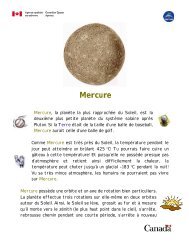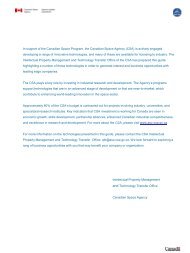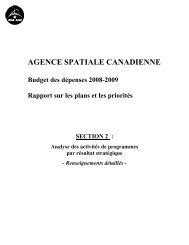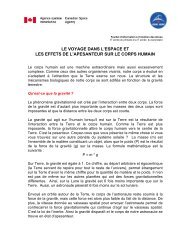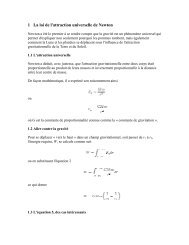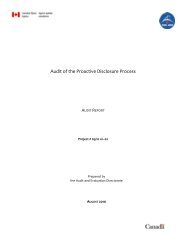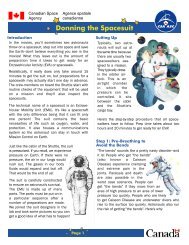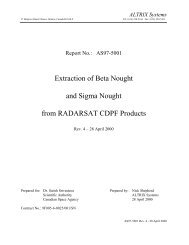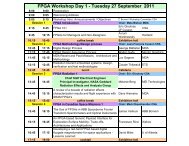PDF version of COSPAR - Space Science Research in Canada Report
PDF version of COSPAR - Space Science Research in Canada Report
PDF version of COSPAR - Space Science Research in Canada Report
You also want an ePaper? Increase the reach of your titles
YUMPU automatically turns print PDFs into web optimized ePapers that Google loves.
oundary layer on Mars is generally higher than on Earth—perhaps four to fivekilometres dur<strong>in</strong>g the day <strong>in</strong> the Arctic because <strong>of</strong> solar heat<strong>in</strong>g, and less at night.“We th<strong>in</strong>k the lidar will be able to tell us is how deep the boundary layer is,” hesaid. “We’re hop<strong>in</strong>g it will detect a horizon—a change <strong>in</strong> the dust concentration atlevels correspond<strong>in</strong>g to the top <strong>of</strong> the boundary layer.” This will depend on thesize <strong>of</strong> the dust particles. If they are large enough to settle out <strong>of</strong> the atmospheresufficiently rapidly at night, scientists will see the top <strong>of</strong> the boundary layer.Unfortunately, some Martian dust is very f<strong>in</strong>e and, once stirred up, settles veryslowly, if at all.The MET science team is <strong>in</strong>terpret<strong>in</strong>g the data collected on the planet by us<strong>in</strong>gcomputer models similar to those used for weather forecast<strong>in</strong>g and climateprediction on Earth to analyze the atmospheric chemistry <strong>of</strong> Mars and the roleplayed by dust.Prepar<strong>in</strong>g for the missionLong before land<strong>in</strong>g, while MDA was build<strong>in</strong>g the <strong>in</strong>struments, the Canadianscientific team conducted studies and tests to prepare for the research programdur<strong>in</strong>g spacecraft operations. The York team, for example, tested components <strong>of</strong>the temperature sensor taken from the same manufactur<strong>in</strong>g batch as thosedest<strong>in</strong>ed for the spacecraft and also built and tested a lidar technically similar tothat dest<strong>in</strong>ed for Mars.Taylor and his students participated <strong>in</strong> an <strong>in</strong>vestigation that prompted a designchange <strong>in</strong> the <strong>in</strong>strument used to collect sub-surface ice samples. From hisprevious research on blow<strong>in</strong>g snow, Taylor knew that when snow is blownaround, it sublimates—changes from a solid to a vapour. He began to wonder ifthis would happen to the ice dug up with a fork-like device on the end <strong>of</strong> therobotic arm on Phoenix—a laborious process that would take several hours.“It seemed to us that scrap<strong>in</strong>g these little chips <strong>of</strong> ice up and deliver<strong>in</strong>g them tothe analysis <strong>in</strong>strument several hours later could be a problem. We thought theseice chips would sublimate. If it takes them several hours to collect a large enoughsample, they’ll never be able to do it because the sample will vaporize.” His <strong>in</strong>itialcalculations suggested that, at a temperature <strong>of</strong> –30 degrees Celsius, the chipswould last only half an hour.This theory was greeted with some skepticism so Taylor had a student who waswork<strong>in</strong>g <strong>in</strong> the Canadian Arctic do some experiments up there. He and someother students also conducted experiments <strong>in</strong> a chamber at York that simulatesMartian conditions. “We found that if the temperature stays below about –4053



